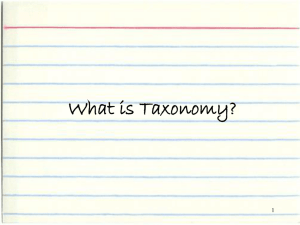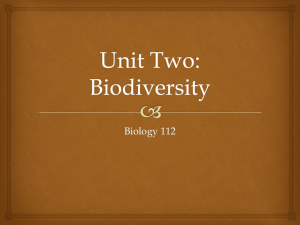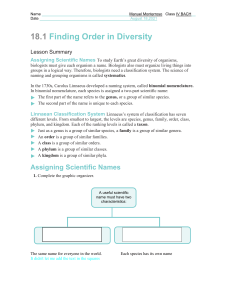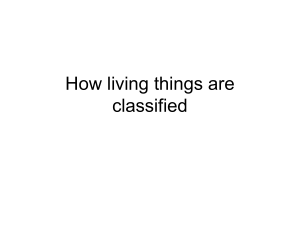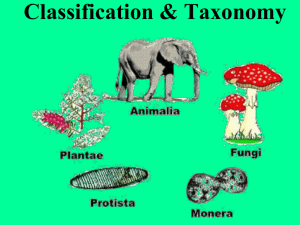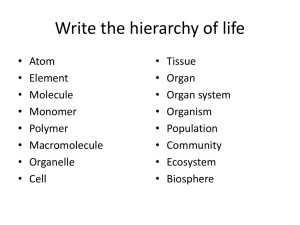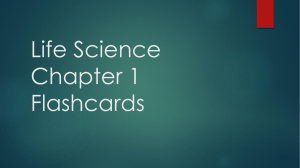Why classify?
advertisement
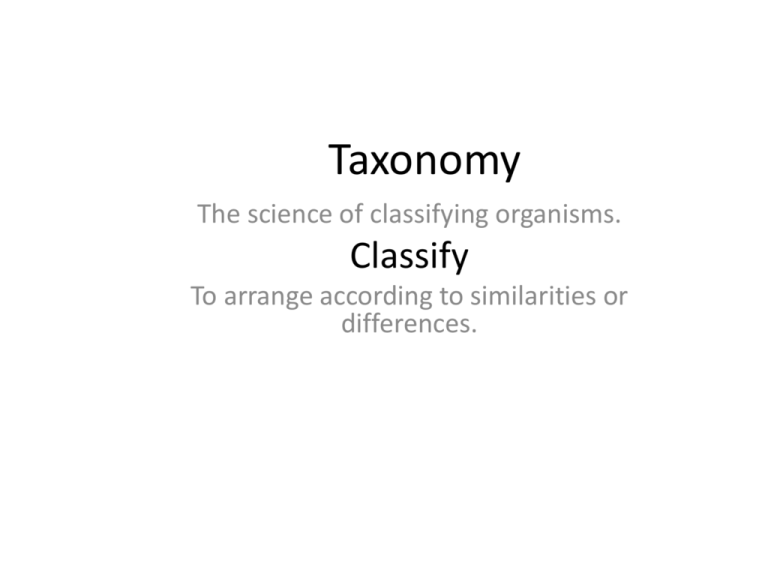
Taxonomy The science of classifying organisms. Classify To arrange according to similarities or differences. Why classify? Biologists use classification to organize living things into groups so that the organisms are easier to study. We classify to make our lives easier. History of Taxonomy Aristotle • • • • Simple classifications Used common names Plant or animal? If an animal does it have blood? does it – Fly – Swim – Walk/Crawl • DISCUSSION QUESTION - Using Aristotle's 3group system (based on movement), name 2 animals that would fit each of the 3 groups. Problems with this system? Some animals can walk, swim, and fly What technology helped scientist improve the classification system? Microscope -1600s Carolus Linnaeus 1700s • Described organisms with two word names, instead of polynomials • Developed binomial nomenclature • First word = Genus name (Capitalized) • Second word = species name (lowercase) scientific name – Example Canis lupus Always italicized or underlined Why binomial nomenclature? • Binomial - 2 name • Nomenclature – naming system • Much easier than a 10+ word name under old “polynomial system” • Same name no matter where you go (Latin) • Less confusion Devil Cat Ghost Cat Mountain Lion Screaming Cat Puma Florida Panther Cougar Felis concolor Taxonomic Hierarchy • Names organisms and their relationships from very broad to very specific Classification of Living Things Milky way Solar System Earth U.S. Ohio Westerville Mainsail Dr. 283 Domain Kingdom Phylum Class Order Family Genus Species Three Domains of Life There used to be 2, why do you think there are 3 now? Domain Archaeabacteria: Life's Extremists...! Archaea are found in the harshest environments on Earth, and are the oldest known organisms on Earth, appearing in the fossil record over 3.6 BILLION years ago (3,600,000,000 years ago!) Domain Bacteria (or Eubacteria): is familiar to most people when associated with human or animal disease. However, most bacterial species do not (and cannot) cause disease. Most species even play beneficial roles for humans by producing antibiotics and food. Domain Eukarya A single-celled or multicellular organism whose cells contain a distinct membrane-bound nucleus. (Organism’s cell has a nucleus.) Domain Kingdom Phylum Class Order Family Genus Species Pro = before Why has taxonomy changed throughout history? Do you think it will continue to change? Prokaryotes • We are now filling out our charts Archaea • Unicellular prokaryotes • Autotrophs • Cell wall Eukaryotes Eu = true Have membrane bound nuclei •Most are unicellular Phylum examples • Chordata Cord Chordates Hollow dorsal nervous chord, notochord, pharyngeal slits, endostyle, post-anal tail about 100,000+ Cnidaria Stinging nettle Coelenterates Nematocysts (stinging cells) about 11,000 Ctenophora Comb bearer Comb jellies Eight "comb rows" of fused cilia about 100 modern species Cycliophora Wheel carrying Symbion Circular mouth surrounded by small cilia Classification of Humans • • • • • • • Kingdom Phylum Class Order Family Genus Species Animalia Chordata Mammalia Primates Hominidae Homo sapiens 52 Is your table filled out? Don’t lose it!!!

